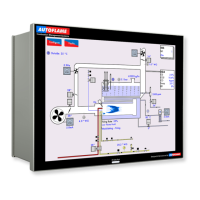17 Fully Metered Combustion Control
Mk8 MM Manual Page | 295
17 FULLY METERED COMBUSTION CONTROL
17.1 Overview
17.1.1 Introduction
The fuel-air mixture determines the combustion performance; poor mixing of the fuel and air reduces the
burner’s combustion performance, and in turn, decrease the combustion efficiency. High fuel-rich
combustion results in incomplete combustion, leaving unburnt fuel in the combustion gas. Unburnt fuel
causes soot build-up and releases harmful CO emissions to the atmosphere. Incomplete combustion wastes
fuel so additional fuel is required to meet the load demand, causing higher fuel cost.
On the contrast, high amount of excess air in the combustion process wastes the heat generated by the
combustion process to heat the excess air and also accelerates the combustion gas travel through the boiler.
This in turns require more fuel to meet the demand and wastes fuel and increase costs. The fully metered
system is used in applications where it is not possible to measure the exhaust gases in the stack, or if the
firing rate is critical to system and controlled remotely.
17.1.2 Importance of Excess Air
In ideal stoichiometric combustion, all the fuel is mixed with the exact amount of air for it to be converted fully
to CO
2
, H
2
O (N
2
), releasing heat from the reaction. In the practical world where ideal and laboratory
conditions do not always exist, it is necessary to add more air than that required in stoichiometric combustion
to ensure complete combustion. The equivalence ratio of the combustion is:
=
=
(
/
)
(
/
)
Or alternatively, if the volume is known:
=
(
/)
(
/
)
Where n is the number of moles of gas, proportional to the corrected volume.
The excess air is the extra amount of air supplied over the amount of air required for complete combustion,
and can be determined from the equivalence ratio:
=
1
=
1
× 100%
This can be converted to the wet exhaust gas O
2
by:
=
21%
1 +
1
Higher excess air levels will give higher O
2
values in the exhaust gases. The optimum excess air will depend
on the fuel type, the combustion chamber design and the burner turndown. High performance burners will
operate 3% O
2
(dry) when firing on natural gas, which is equivalent to 15% excess air going into the burner,
whilst producing 0ppm of CO. The stoichiometric data in the lookup tables of the software is gives the excess
air based on the fuel and air flow rates, and the calorific value of the fuel.

